Potato Onion (Allium cepa var. aggregatum)
About Potato Onions
Description
The potato onion (Allium cepa var. aggregatum) is a member of the onion family that reproduces primarily by division of bulbs, rather than by seed. This makes it more similar in form to garlic than to standard onions. They were once a mainstay of northern garden plots, where they were easier to grow than standard onions from seed. They are also known as nesting onions or multiplier onions.
Potato onions are closely related to shallots, which are also A. cepa var. aggregatum. Shallots are generally better known than potato onions. Although potato onions and shallots have just enough differences to represent two families of cultivars, the exact dividing line between the two is hard to place. Potato onions are larger, divide into fewer bulbs, and remain enclosed within the skin of the seed bulb longer (Fritsch 2002). Shallots typically have milder flavor and poor storage characteristics, while potato onions typically have a sharper flavor and store much better.
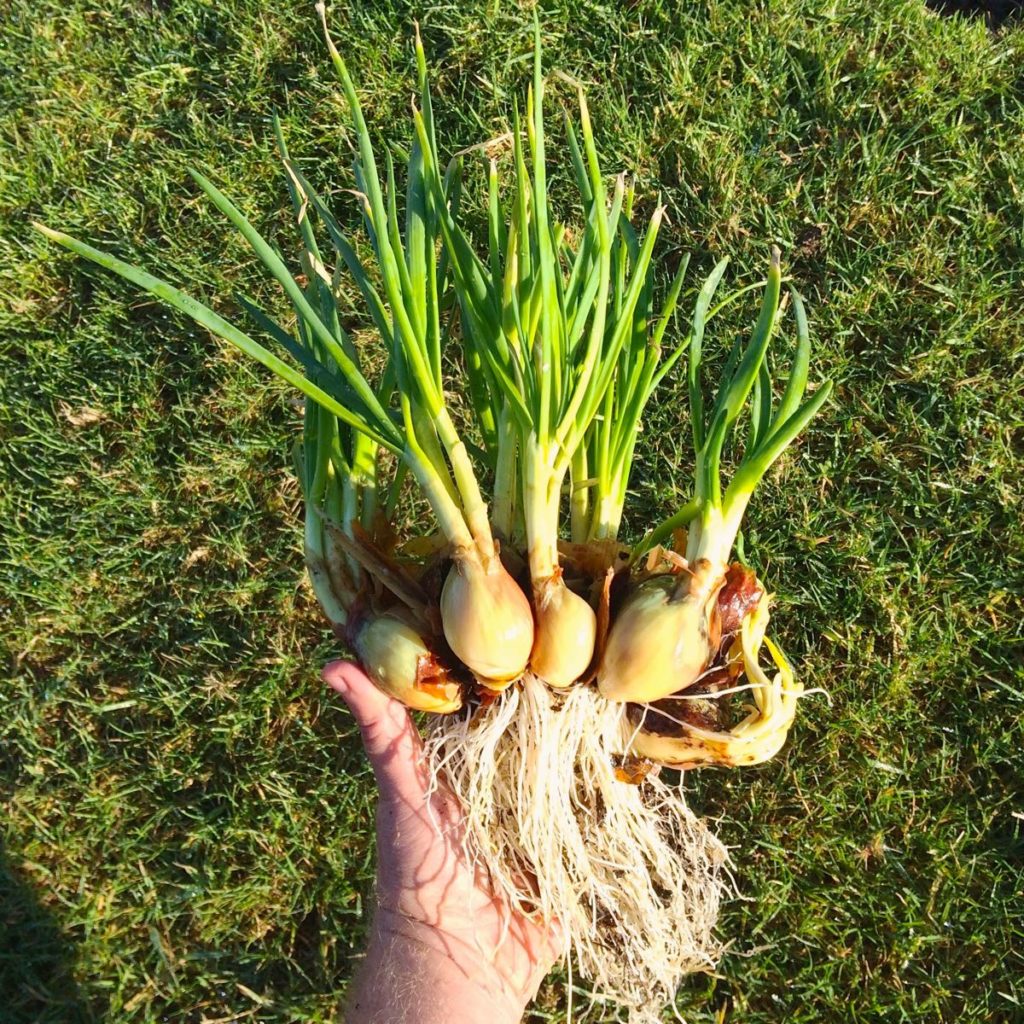 Potato onions are more commonly grown by replanting the bulbs than by starting from seed. This distinguishes them from conventional biennial onions, which must be started from seed. Nesting bulbs should not be confused with sets that are used to start biennial onions. Sets are actually small onions that somebody else started from seed; this is different than the propagation of potato onions, which directly produce bulbs that can be used to propagate the plant.
Potato onions are more commonly grown by replanting the bulbs than by starting from seed. This distinguishes them from conventional biennial onions, which must be started from seed. Nesting bulbs should not be confused with sets that are used to start biennial onions. Sets are actually small onions that somebody else started from seed; this is different than the propagation of potato onions, which directly produce bulbs that can be used to propagate the plant.
The individual bulbs are smaller than most conventional onions. Potato onions range from about half an inch to two inches (1.2 to 5 cm) in diameter, although some newer varieties produce larger bulbs.
Potato onions can be replanted indefinitely and harvested annually, which makes them easier to manage than biennial onions that must be grown from seed each year.
History
The origin of shallots and potato onions is uncertain. The earliest clear records of their use come from 12th century France (Fritsch 2003).
Potato onions were once a popular crop in North America, but fell out of favor in the early twentieth century, along with many other staples of the home garden. One possible reason for this is the additional labor involved in harvesting potato onions. Because they grow in a nest that must be divided, they are not as suitable for mechanical harvest as individual standard onions. The storage of bulbs for propagation can also be expensive on a large scale.
Potato onions are grown as a home or small farm product in Europe, North America, and parts of Russia and central Asia. They are grown commercially in Brazil and India (Fritsch 2003). They were grown in Finland commonly until the middle of the twentieth century and 22 varieties have been identified there (Heinonen 2014). Potato onions were reportedly once grown from seed in Russia, which may account for the rich diversity in Northern Europe, where seed production is rare (Leino 2014).
Nutrition
I haven’t turned up any nutritional analyses of potato onions, but they are probably very similar to biennial storage onions.
Cooking and Eating
All parts are edible. You can snip the new leaves as green onions. The bulbs substitute well in recipes calling for storage type (not sweet) onions. Try incorporating them into soups or baked into breads.
Cultivation
Climate Tolerance
Onions of all types are pretty hardy plants that originated in cold climates. They can handle climates as cold as USDA zone 4 and perhaps colder if there is some snow cover or if a thick mulch is applied.
Photoperiod
Onions are perhaps the most familiar vegetable with photoperiod dependencies. Some require long days, some require short days, and some are day neutral: they will form bulbs at any time of year.
Most potato onions are long day plants that only bulb well north of 37N latitude (or south of 37S). There are a few short day or day neutral varieties grown in the South.
Soil Requirements
Potato onions are tolerant of a wide range of conditions, but prefer mildly acidic to neutral pH and will do best in organically rich, well drained soil.
Propagule Care
Bulbs
Onions keep best at cool, but not cold temperatures. 50 to 60° F (10 to 16 C) and low humidity is a good combination for storing onion bulbs.
Seeds
Onion seeds have a short storage life; germination declines quickly after a year when they are held at room temperature. Stored below 40° F (4 C), they retain good germination out to at least three years. They have no dormancy, so they can be sown as soon as they are harvested.
Planting
Bulbs
Much like any other northern onion, you can choose to plant in fall or spring (or winter in mild climates). Fall planting gives a bit of a head start but, in some cases, can trigger flowering. Fall planted potato onions may mature as much as a month earlier. Spring planting also works very well and may be a better choice in wet climates, since bulbs may rot in consistently wet soil.
Bulb dormancy can be broken with two weeks of vernalization at 50° F (10 C) (Sumanaratne 2002). Perhaps for the same reason, fall planting increases the number of plants that bolt to seed in spring in some climates (maritime climates, in particular). This can be useful if you want to produce seed, but the flower stalks are best removed if you don’t want seed, as they tend to reduce bulb size.
Heat treatment can be used to prevent varieties from flowering. The bulbs are warmed in 104 to 107° F (40 to 42 C) water for one hour (Heinonen 2014) before planting. This also helps to break dormancy.
In mild climates, where the plants will grow through the winter, plant the bulb with the tip just at the surface of the soil. In colder climates, where most of the growth will occur in spring, it is probably better to plant with the top below the surface of the soil for greater protection (Winter 2011).
Seeds
Starting potato onion seed is no different than starting other onion seeds. If you live in a mild winter climate and are a bit of a gambler, you can direct seed in early autumn. Otherwise, start seeds indoors about two months before your last frost.
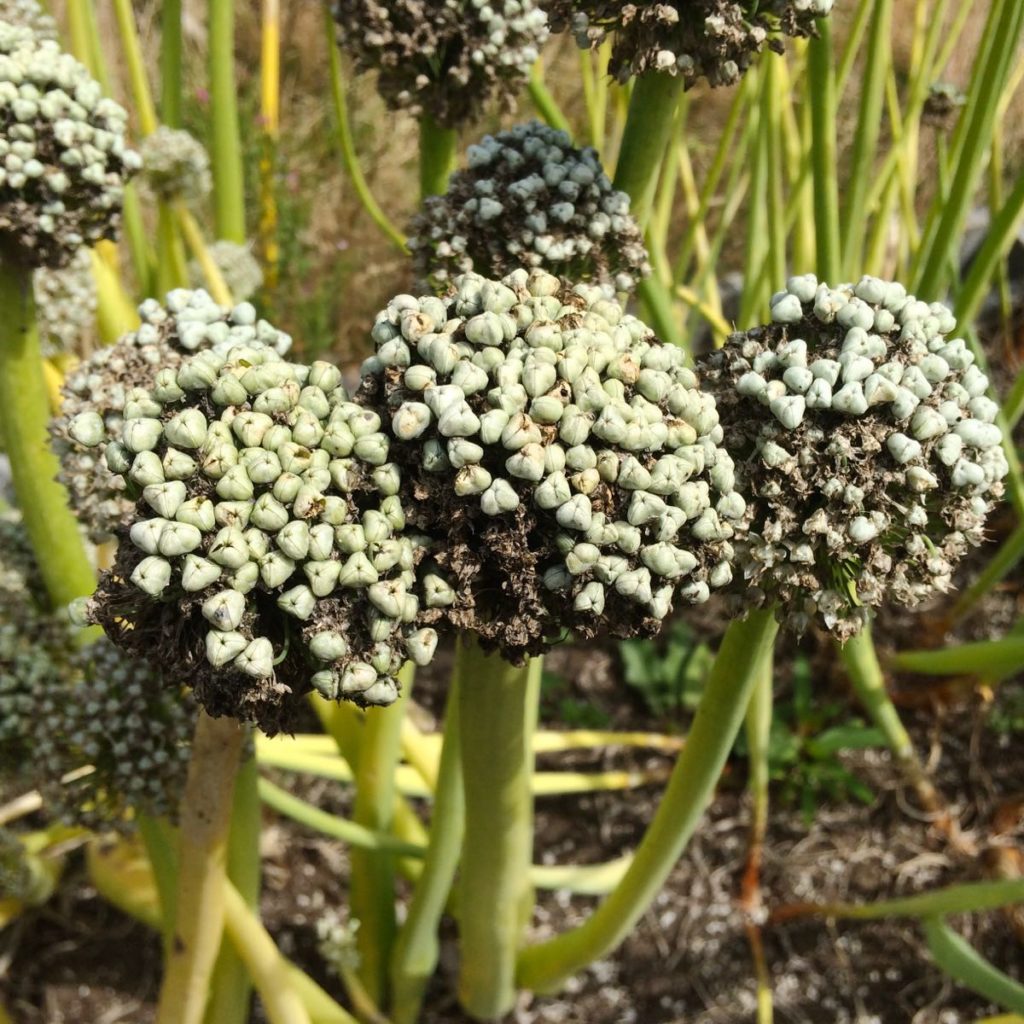
Scatter seeds and press into the surface of the soil. Provide strong light. Keep the soil moist until the seeds have germinated. Germination takes up to three weeks and is not as regular as that of standard onions. Plan for 60% germination at best. Harden off and transplant when the plant reaches about three inches (7.5 cm) in height.
Management
Onions are heavy feeders and will benefit from a boost of high nitrogen fertilizer early in spring when they start forming new leaves. Keep them well weeded as they don’t compete well with tough weeds. Otherwise, onions require very little care.
Companion Planting
Because they take up such a small area of ground, potato onions make good companion plants. They are also pretty when they flower and can be incorporated into ornamental beds. Potato onions combine well with plants that do not have to be dug for their roots. Bush beans and peas work well planted among onions. Carrots, parsnips, root parsley, and other tap rooted plants work well, especially in their second year when you are saving a seed crop.
Growing as a Perennial
Potato onions help you to live the dream of a care free food forest. They are well behaved, propagate themselves, and provide some kind of harvestable product at all times of the year in mild climates. I like to let them grow in a bed for several years, harvesting as needed, and thinning a little whenever I pull a plant. Eventually, conditions will get crowded and yields will go down; then, you have to renovate the bed. If you have the space, that is a good time to move the plants into new ground, which may help to prevent accumulation of pests and diseases.
Container Growing
Potato onions grow very nicely in containers. A gallon (4 l) pot will grow a single plant and the yield should be nearly as good as growing in the ground, as long as you keep the plants well watered.
Harvest
Green onions (new leaves) can be harvested fall, winter, and spring. Snip a few leaves from different plants to spread the damage. As long as you don’t cut more than ten percent, the effect on yield is minimal.
Bulbs are usually harvested in July and August, much the same as other onion varieties. This is when they are at their best, but you don’t have to harvest them all. Once the onions have bulbed, you can harvest them at any time. Usually, they will sprout in the fall, but the bulb quality remains pretty good all the way through the winter.
Storage
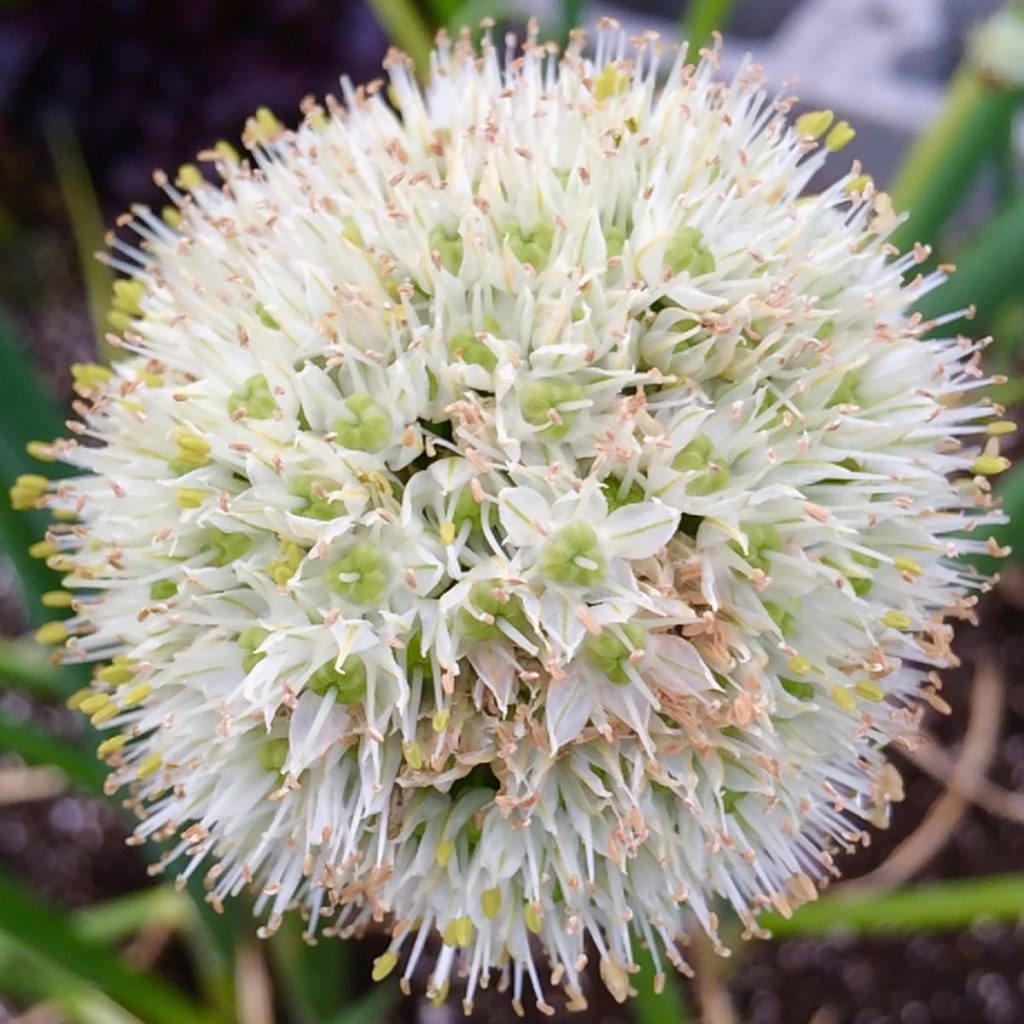
Like standard storage onions, potato onions keep best at cool, but not cold temperatures. Temperatures of 50 to 60° F (10 to 16 C) and low humidity is a good combination for storing onion bulbs. Don’t store your onions in colder conditions, particularly not in the refrigerator. Quality degrades rapidly at low temperatures and they tend to rot before planting time.
Preservation
Onions are typically either dried or pickled. Potato onions are great for pickling, as the range of sizes is very convenient. Overall, though, one of the main benefits of potato onions is that they store really well and don’t require much effort to preserve. Potato onions will often store for more than a year in an open box in a cool pantry.
Propagation
Potato onions can be planted from bulbs, which is the usual practice, or from seeds. All varieties are hybrids, so they will not grow true from seed. Instead, you get new varieties to evaluate.
Vegetative Propagation
Replanting couldn’t be easier. When harvesting, remove one bulb from the nest and replant. It is best not to plant in the same place for too long. I maintain a perennial patch of potato onions in the same place for three or four years and then relocate.
The dormancy period of potato onions is eight to ten weeks, although this can be extended substantially with cool, dry storage conditions.
There is not an easy way to propagate potato onions by cuttings.
Sexual Propagation
Potato onions are able to produce true seed, although it may take some work to convince them to do so. The most reliable way to force potato onions to go to seed is by planting them in early fall and allowing them to overwinter. Getting good early growth is important. If your potato onions are about a foot (30 cm) tall by the time freezing weather arrives, you should have a good chance of producing seed. Bulb size also plays a significant role in flowering, with bulbs of 1.2 inch (3 cm) diameter or larger flowering at more than four times the rate of smaller bulbs (Sumanaratne 2002).
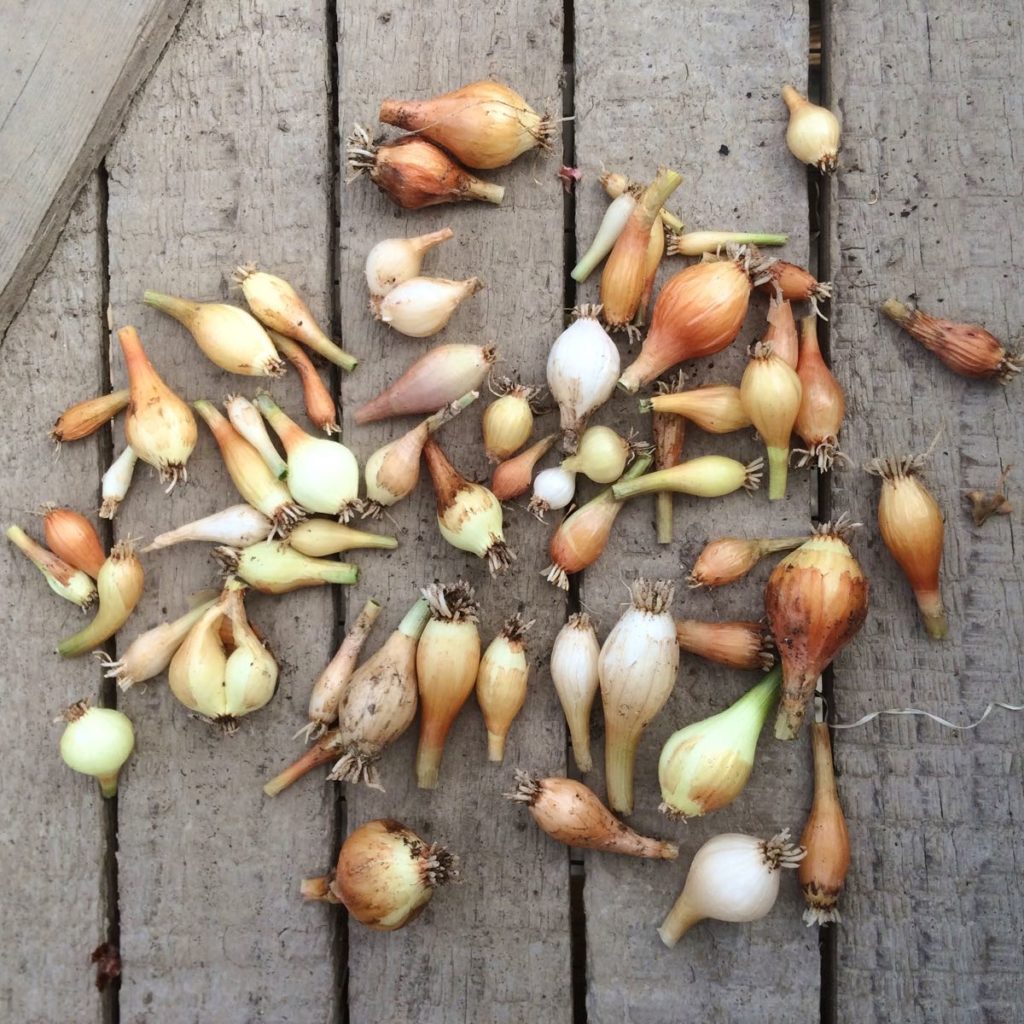
Onions are insect pollinated and a reasonably pure crop requires isolation from other flowering onions at a distance of at least 100 feet (30 m), and preferably more. Some crossing will still occur at this distance, but I’m assuming that ninety percent purity is sufficient. For that matter, crossing with other types of onions may produce very interesting results. If you isolate a single variety of shallot or potato onion, the seeds will produce a very similar variety, although seed set will often be poor.
If you allow different varieties of potato onions to cross, then you will obtain new varieties with new characteristics. If you allow potato onions and shallots to cross, then you will generally still produce nesting onions, but they may have a wider range of characteristics. If you allow potato onions to cross with other kinds of onions, the progeny may not all be nesting types, although some probably will be, and you may get some really interesting new traits.
In short, you can get lots of different types of both annual and perennial onions by allowing wide crossing between types. Eat the annuals and propagate the perennials. You may find that you get something really good.
I see a lot of pollinator interest in potato onions, mostly honey bees and hover flies. Still, they seem to be more efficient with the flowers on the top side of each flower head. You can improve seed set by cutting a few flower heads and brushing them against the undersides.
Problems
Pests
Onions are happily a pretty pest free plant. Onion fly can be a problem, but is typically only a serious threat to seedlings. Plants grown from bulbs can be cosmetically damaged, but usually survive to produce a normal yield. Slugs sometimes show some interest in potato onions, but if you keep the soil hilled up to protect the bulb, they can’t do any serious harm.
Diseases
Onions are vulnerable to a lot of viral diseases that usually don’t kill the plant but do reduce yield. This is a common problem with clonally propagated crops like potato onion. You may notice that the size of your onions decreases over time. This is often a result of virus burden. If your potato onions flower, you might try collecting some seed to grow new plants. If you keep them isolated from other onion varieties, any seeds that you collect should produce plants that are reasonably similar to the variety that you started with, but the onions will often be larger because they lack the accumulated viruses of the parent plant.
Defects
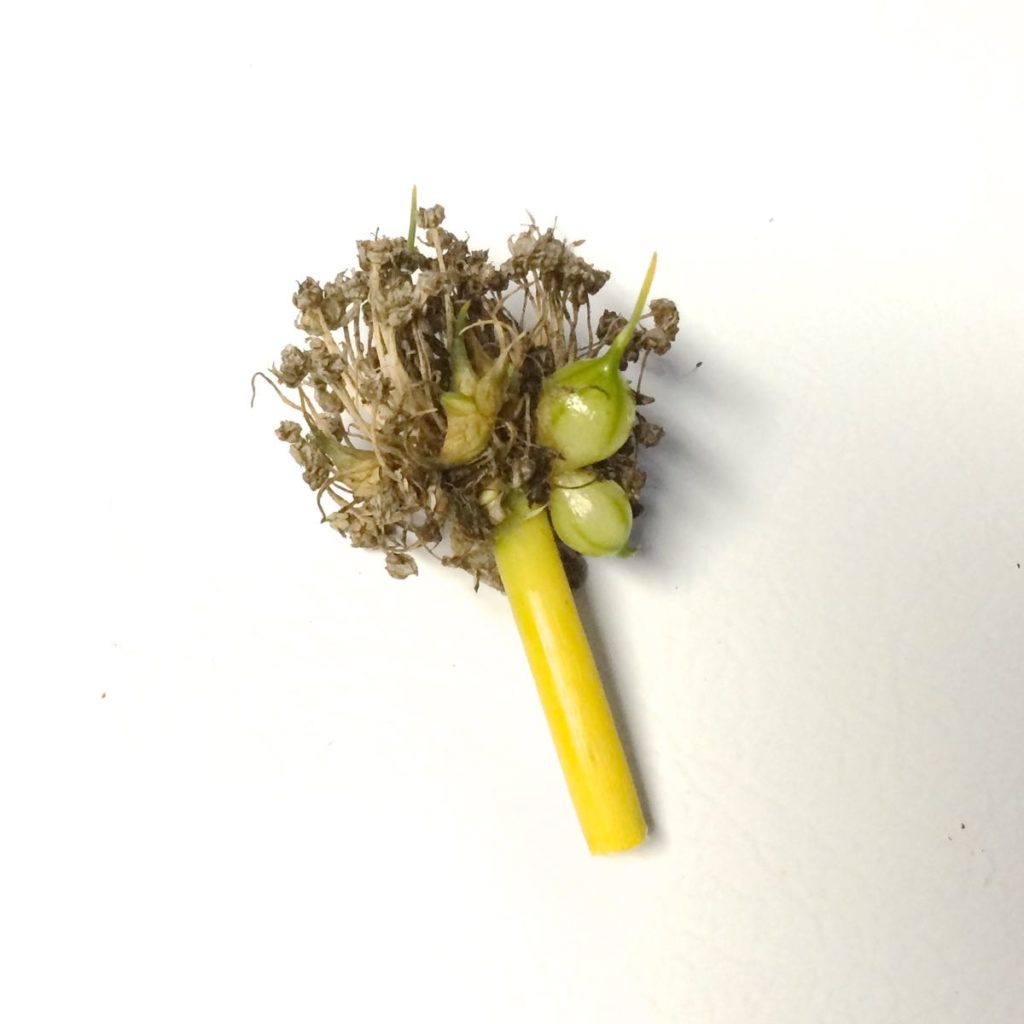
Potato onions have a lot of interesting reproductive defects. You may see some plants that flower normally and set seed, some that cannot be persuaded to flower at all, some that produce rare bulblets among the flowers, or even varieties that replace flowers entirely with bulblets. It may be possible to select new top set type onions from potato onions that produce bulblets, although these are not “true” top set onions, because they are a different species.
Crop Development
Shallots and potato onions are closely related and interfertile, so there is good potential for crossing the two in order to bring improved flavor and strong storage characteristics closer together. Also, breeding either of them against annual onions has the potential for introducing new traits (such as improved size) while retaining perenniality. I think that there is a lot of exciting potential here. Big agriculture may have little use for perennial onions, but they are fantastic for home growers.
21 thoughts on “Potato Onion (Allium cepa var. aggregatum)”
Leave a Reply
You must be logged in to post a comment.

Will this do well in zone 9b?
If you can grow onions at all, then you can almost certainly grow potato onions. However, potato onions are long day onions, so if you are in zone 9b below the 36th parallel, then they won’t get long enough days to bulb up well.
Technically speaking, day-length genetics are affected by the length of uninterrupted dark, not continuous light. The more correct term would be “short night” onion instead of “long day” onion.
Because of this, you can use 15-30 minutes of artificial light at a PAR of 300+ once or twice overnight and trigger the proper bulbing of “long day” onions as close to the equator as you like.
This works because you are giving sufficient light exposure to force “daytime” gene expression before the plant experiences enough consecutive hours of dark to suppress bulbing.
Short day, or “long night” onions require blackout enclosures in northern lattitude in order to allow long enough uninterrupted dark periods to suppress bulbing for long enough to develop sufficient vegetative growth to support good-sized onions once bulbing is initiated.
Excited to harvest my first crop of potato onions! Should I replant the small ones or the big ones?
With any clonally propagated crop, I always replant the best. This helps to ensure that unwanted mutations aren’t creeping in.
Hi Bill,
Curious if there are any companion plants that can help protect potato onions from any diseases?
These things are amazing! It’s my first crop in Southeast Alaska and I am seeing 8-12 bulbs growing out of each bulb I planted! Should I be covering them with dirt as they grow up and out? They are literally growing on top of the soil and on top of one another in big exposed clumps.
Those extra long Alaska days give you an edge. No need to cover unless you are having problems with critters getting at them.
Hi Bill, love your website. Was unsure how to start a new comment but, will comment here as I too am far north 58° (north coast of Scotland) & I planted 5 different varieties of potato onion late fall and all mine are going to seed rather than doing much multiplying! (The bulbs came from a reputable source) A handful have split into 2 or 3 new ones plus going to seed. One looks like a giant leek! Is it any good letting these all cross & trying to save seed?
Do potato onions actually grow more than one onion from one bulb?
Yep, that is pretty much the only thing that makes them different from other onions.
Should I save small or larger potato onions for replanting in spring I have read to save big ones and have read that smaller potato onions are best?
I’m not sure that it really matters, but my rule of thumb is “replant your best.” With clonal crops, you have the possibilities of both somatic mutations and disease, both of which can be responsible for reducing size and yield. If you replant your best, those are the least likely to have suffered a mutation or infection that will result in a lower quality crop.
I think the general rule of thumb is that planting small bulbs yields fewer bulbs of larger size whereas planting large bulbs yields more numerous bulbs of smaller size.
Have a try and let us know what you reckon.
I like having a range of sizes to use and, as Bill says, keep the most excellent for planting to propagate.
I wonder if an ‘ideal’ variety would have a standard size? I’ve got one which appears to like making nests of uniform-sized 2″ diameter bulbs. Currently up to 15-20 bulbs which I planted 1 week ago.
Thanks for this great post! I am a first-time grower and live in San Mateo, CA, Zone 10a. I will be planting yellow potato onions and just want to make sure I am doing this correctly. I have two, 13cf round cloth containers – 48″ diameter, 12″ depth. I am wondering how many I should plant in each container and if now is a good time or if I should wait a couple of months (I received my bulbs ~two weeks ago).
Also, for my zone, do you recommend vernalization and/or heat treatment by soaking?
Thank you so much!
Hello, I live in South Australia so spring coming into summer here, we have a Mediterranean climate where its usually dry and hot from November through to March. My potato onions are going to seed, they have not formed bulbs yet so not sure whether I should trim the seed heads for now or just leave them to mature ?
Hi, I live in Tasmania and have just harvested my first potato onions which I intend in pickle. Do you have to dry the onions first before pickling them?
I planted potato onion seed last year and got a nice crop of divided onions as a result. Per everything I read I saved bulbs and replanted them. This year every single onion planted split in multiples and then every single onion made has gone to seed. What did I do wrong?
Some people would be delighted to have all of their potato onions go to seed, so from that standpoint, you might view it as a success. There are several possibilities why your onions would go to seed in the same year they divided. One is that your day length is too short for long day onions. Do you live at a latitude less than 35 degrees? If so, your onions may have gotten the signal to attempt sexual reproduction based on day length. A variation on this occurs when the plants matured early in their seedling year, as often happens, and therefore the plants emerged early and grew for too long under shorter day length early in the year. Another possibility is stress. If the plants are subjected to high stress, they will sometimes bolt to seed. Finally, it is possible that the potato onions crossed with regular onions and the resulting progeny have lost the perennial characteristics of potato onions.
Are you familiar with Kelly Winterton’s work on ressurecting potato onions?
https://sites.google.com/site/kellysgarden/potato-onions
Yes, I am a big fan of his work. I grew a number of his early selections and incorporated them into my seed grown population.